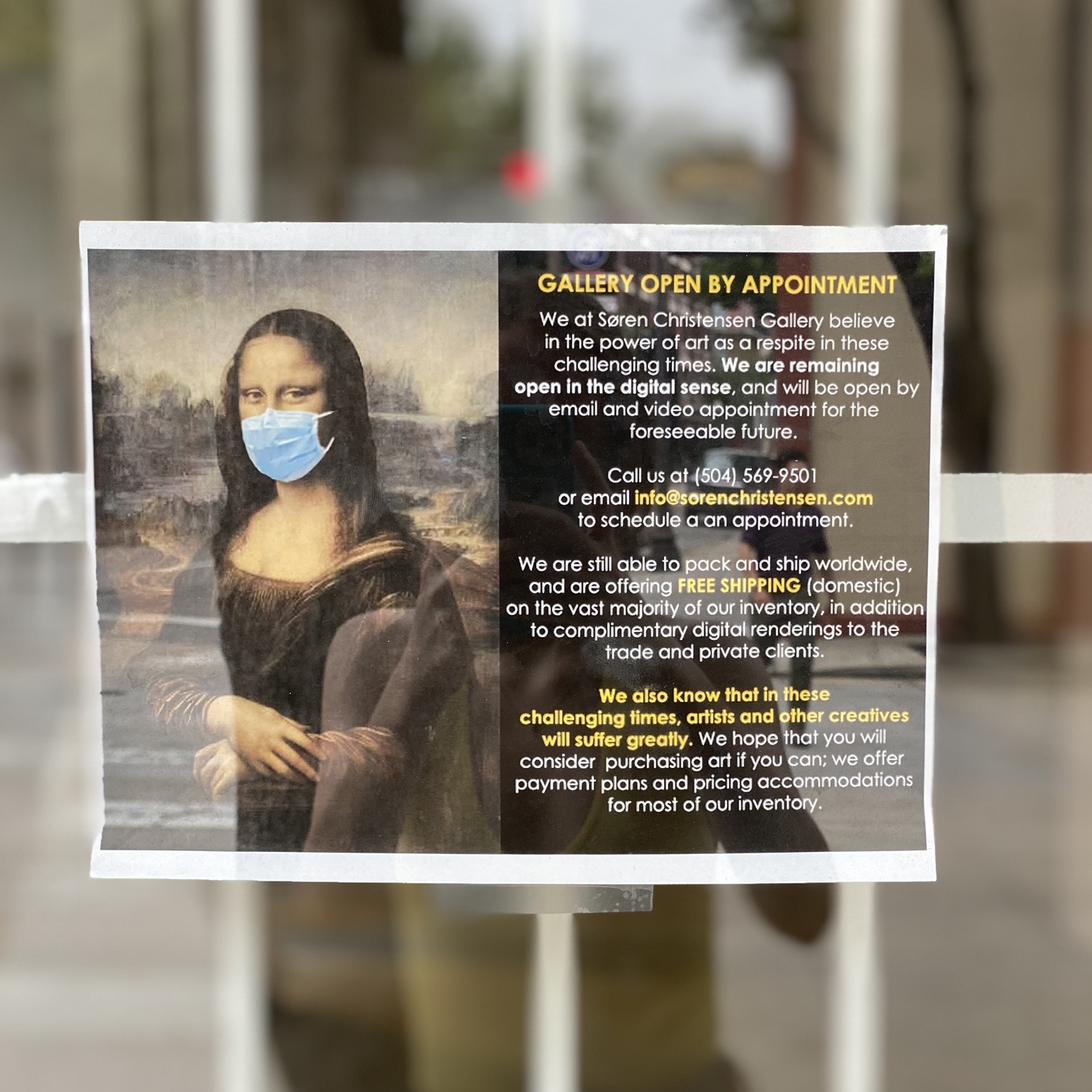
Poster at Soren Christensen Gallery, letting patrons know the expectations in this “new normal.” (Photo by: Avery Anderson)
Arts and culture are the lifeblood of New Orleans. Though legislation may not label cultural institutions as “essential,” we New Orleanians know that art galleries, music halls, and museums are just as crucial to our way of life as a weekly trip to the supermarket. But when the pandemic relegated us to our homes, it also altered our personal interactions with art. Unable to see a live play or walk through a museum, cultural institutions began to bring the arts into our homes while also changing the way we interact with them in community spaces.
As the way we consume and appreciate art evolves, we may find ourselves asking how arts and culture will survive the “new normal.” How can you put on a play in the midst of a pandemic? How do social-distancing regulations impact a gallery tour? The culture industry has been forced to innovate, coming up with new ways to deliver live experiences, whether they be virtual or in-person.
One innovative approach has been the digitization of museum archives, heralding an era of increased accessibility as cultural caretakers like the Ogden Museum move their exhibits online. The Ogden’s “See the South” exhibit is now fully virtual, allowing anyone with a computer to access a wealth of regional artistry, both archival and current. From photography exhibitions to abstract art, the newly digital “See the South” exhibit works to correct “the omissions of the past” by highlighting the creative endeavors of Black artists.
As museums move their exhibits online, other organizations make plans to host in-person events that comply with social distancing guidelines. One of the most innovative examples of this shift is Voodoo Fest’s Drive-In Summer Concert Series. Adopting the format of a drive-in movie theater, this concert series invites music lovers to enjoy the concert experience from the comfort of their own vehicles. Boasting a lineup of local musicians like Tank and the Bangas, Galactic, and The Revivalists, Voodoo’s take on public-health-conscious entertainment merges nostalgia and efficacy for a truly innovative experience.
But while museums and festival groups tailor large-scale entertainment for pandemic audiences, brick-and-mortar establishments must overcome a different set of challenges. “Reopening has been off to a slow start with not a lot of walk-in traffic,” says Christy Wood, co-owner and gallery director of LeMieux Galleries. Though LeMieux continued fulfilling online sales during the pandemic, Wood understands why people may be reluctant to visit the gallery in person. “People are still being cautious as to how they spend time outside of their homes.” The people at LeMieux, she adds, “are grateful to our existing and new clients who have been willing to add some new art to their collections during this trying time.”
But what does a traditional business’s “new normal” look like, and how does the socially-distant gallery experience differ from the pre-COVID one?
“New normal means all employees wear a mask when working with another person,” Wood says, “and everyone is required to wear one to visit the gallery.” Adhering to Phase Two reopening guidelines also means sanitizing, and lots of it. The folks at LeMieux are responsible for “cleaning shared surfaces multiple times a day” and making sure that clients keep their hands off of the artwork. “We do ask that people not touch anything, but that’s really no different than in pre-Covid times,” Wood says.
Despite these protocols, Wood says that the new gallery experience is as good as (or better than) the pre-Covid one. With social distancing, “you are allowed the space to enjoy the artwork” one-on-one. This added elbow room gives gallery viewers the opportunity to appreciate the art “without worrying about having a lot of people around you,” making the gallery experience safer and more intimate. When viewers are able to experience the artwork one-on-one, it is easier for them to form a personal connection with a piece. “The benefit of coming into the gallery is the ability to interact with the physical object,” Wood says. Seeing the way a piece “‘moves’ in the light [and] the layers and depth that aren’t always evident in a still shot” makes an in-person aesthetic experience all the more rewarding.
 NOLAbeings
Multimedia artist Claire Bangser created NOLAbeings as a portrait-based story project that marries...
NOLAbeings
Multimedia artist Claire Bangser created NOLAbeings as a portrait-based story project that marries...
 Data corner: Adobe Suite (create a PDF, social media graphic, presentation, edit a photo and video
Data corner is where you go to work with analytics and top tech skills. It takes on everything from PERL and SQL to Canva and Sprout Social.
Data corner: Adobe Suite (create a PDF, social media graphic, presentation, edit a photo and video
Data corner is where you go to work with analytics and top tech skills. It takes on everything from PERL and SQL to Canva and Sprout Social.
